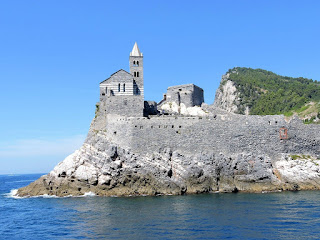Ligurië - Liguria
Geography and climate
In the northwest of Italy lies the Liguria region, with Genoa as its capital. It is the third smallest region of Italy. Liguria is 5,422 km² big, it has about 1.8 million inhabitants and it borders France. There are 4 provinces: Genoa (GE), Imperia (IM), La Spezia (SP) and Savona (SV).
Liguria is a coastal region known for its rocky coast. The region has a whole series of famous and less famous seaside resorts such as Sanremo, Rapallo, Savona and Alessio, and tourist attractions such as Portofino, Cinque Terre and Porto Venere.
World famous is the Pesto alla Genovese, a sauce made with basil. The Ligurian kitchen has an endless list of typical regional dishes in which many herbs are used: thyme, sage, rosemary, oregano, marjoram and of course basil.
Due to its location on the coast, fish is an important product in the recipes. Seafood risotto is a common dish in restaurants. Very typical is focaccia /foˈkatʧa/, which looks like a thick pizza with a crispy salted crust. This flatbread originates from Genoa but is eaten all over Italy, although it is called differently in some regions. The farinata di ceci, is famous and is a kind of salted pancake made with chickpea flour. Wine is produced in Liguria on a small scale and mainly for local consumption.
The main source of employment in Liguria is tourism, but the region is also important for its industry. The largest port in the Mediterranean is Genoa, but Savona and La Spezia are important ports too.
In La Spezia you will find a lot of heavy industry and there is also a large military naval base. The region is known for the floriculture.
In La Spezia there are Brugnato, Deiva Marina, Framura, Montemarcello, Tellaro, which is a sub-municipality of Lerici, Varese Ligure and Vernazza and in the province of Savona Castelvecchio di Rocca Barbena, Colletta in the municipality of Castelbianco, Celle Ligure, Finalborgo, Noli, Laigueglia, Millesimo, Verezzi and Zuccarello.
 |
| Porto Venere |
The capital of the region is Genoa, the birthplace of Christopher Columbus. Genoa has the second most important freight port in Italy. The region has another important port, La Spezia.
Airport: Genoa. For those travelling to the west of the region, Nice Airport in France is an option.
Liguria is known for its mild climate all year round. The weather in the region is influenced by both its proximity to the mountains and the sea. The summer months are pleasantly warm, with high average minimum temperatures. Because of the proximity of the Ligurian Apennines the provinces of Genoa and La Spezia are the coastal provinces with the most rainfall in Italy. The winter months are cool without really getting cold. The proximity to the sea ensures mild temperatures and the mountains north of Liguria form a barrier against the cold northern air supply.
In the Liguria region there is little risk of earthquakes.
Food and drinks
 |
| Pesto alla Genovese |
Economy and Healthcare
 |
| La Spezia |
In La Spezia you will find a lot of heavy industry and there is also a large military naval base. The region is known for the floriculture.
The region of Liguria ranks second in terms of crime index, with 5,434 reported crimes per 100,000 inhabitants, well above the national average of 3,816.
Healthcare in Liguria is divided into 5 districts, one per province, with exception of Genova where there are two districts. There are 19 hospitals. More information can be found on the website of the health care of the Liguria region, Alisa Liguria.
Holiday homes
Property prices in the Ligurian seaside resorts are very high, as there is a huge demand from the domestic market of the nearby cities of Turin and Milan.
Most beautiful towns and village
The most beautiful villages in Italy can be found on the website and in the guide “I Borghi piu Belli d'Italia”. In this guide with the most beautiful villages you will find Campo Ligure and Moneglia in the province of Genoa, and in the province of Imperia Apricale, Badalucco, Ceriana, Cervo, Diano Castello, Lingueglietta, Perinaldo, Seborga, Taggia and Triora.
 |
| Tellaro |
The "Bandiera Arancione" is awarded by the Italian Touring Club. This Orange Flag is awarded to promote less known villages. The villages are annually selected for their hospitality and culture. For example, villages must update and maintain their services for tourists, guaranteeing maintenance, and good access to museums and other attractions. Airole (IM), Badalucco (IM), Castelnuovo Magra (SP), Dolceacqua (IM), Pigna (IM), Pignone (SP), Santo Stefano D'Aveto (GE), Sassello (SV), Toirano (SV), Vallebona (IM) currently have an Orange Flag.

